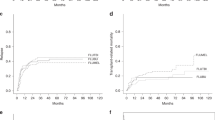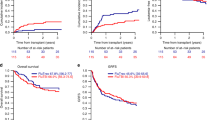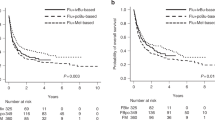Abstract
Fludarabine with intravenous busulfan (6.4 mg/kg; FB2) and fludarabine with intermediate-dose melphalan (140 mg/m2; FM140) are the most widely used reduced-intensity conditioning (RIC) regimens for allogeneic hematopoietic stem cell transplantation. FM140 generally has a lower relapse rate and higher non-relapse mortality (NRM), resulting in overall survival (OS) comparable to that seen with FB2. To evaluate the effect of reducing the melphalan dose, we retrospectively compared transplant outcomes in 156 patients who received FB2 (n = 103) or FM80 (n = 53) at our center (median age: 63 years; range 27–72 years). All patients received 4-Gy total body irradiation. Three-year OS, the cumulative incidence of relapse, and NRM were comparable between groups (FB2 vs. FM80, 58% vs. 47%, p = 0.24; 30% vs. 36%, p = 0.57; 17% vs. 21%, p = 0.44, respectively). There was no significant difference in the cumulative incidence of graft-versus-host disease (GVHD) at day 100, chronic GVHD at 3 years, or the 3-year GVHD-free/relapse-free survival rate. In the high-risk disease group, patients receiving FM80 tended to have lower 3-year OS (FB2 vs. FM80, 48% vs. 17%, p = 0.06). In summary, transplant outcomes following FB2 or FM80 were comparable except in patients with high-risk disease.




Similar content being viewed by others
References
Copelan EA. Hematopoietic stem-cell transplantation. N Engl J Med. 2006;354:1813–26.
Federmann B, Faul C, Meisner C, Vogel W, Kanz L, Bethge WA. Influence of age on outcome after allogeneic hematopoietic cell transplantation: a single center study in patients aged 60. Bone Marrow Transpl. 2015;50:427–31.
McClune BL, Weisdorf DJ, Pedersen TL, Da Silva GT, Tallman MS, Sierra J, et al. Effect of age on outcome of reduced-intensity hematopoietic cell transplantation for older patients with acute myeloid leukemia in first complete remission or with myelodysplastic syndrome. J Clin Oncol. 2010;28:1878–87.
Baron F, Maris MB, Sandmaier BM, Storer BE, Sorror M, Diaconescu R, et al. Graft-versus-tumor effects after allogeneic hematopoietic cell transplantation with nonmyeloablative conditioning. J Clin Oncol. 2005;23:1993–2003.
Bacigalupo A, Ballen K, Rizzo D, Giralt S, Lazarus H, Ho V, et al. Defining the intensity of conditioning regimens : working definitions. Biol Blood Marrow Transplant. 2009;15:1628–33.
Shimoni A, Hardan I, Shem-Tov N, Rand A, Herscovici C, Yerushalmi R, et al. Comparison between two fludarabine-based reduced-intensity conditioning regimens before allogeneic hematopoietic stem-cell transplantation: fludarabine/melphalan is associated with higher incidence of acute graft-versus-host disease and non-relapse mortal. Leukemia. 2007;21:2109–16.
Yuji K, Miyakoshi S, Kato D, Miura Y, Myojo T, Murashige N, et al. Reduced-intensity unrelated cord blood transplantation for patients with advanced malignant lymphoma. Biol Blood Marrow Transplant. 2005;11:314–8.
Harada K, Tachibana T, Ohashi K, Ozawa Y, Sawa M, Kondo T, et al. The effect of melphalan dose and total body irradiation as reduced-intensity conditioning for acute lymphoblastic leukemia patients undergoing allogeneic stem cell transplantation. Leuk Lymphoma. 2019;60:3521–8.
Holtan SG, DeFor TE, Lazaryan A, Bejanyan N, Arora M, Brunstein CG, et al. Composite end point of graft-versus-host disease-free, relapse-free survival after allogeneic hematopoietic cell transplantation. Blood. 2015;125:1333–8.
Sorror ML, Maris MB, Storb R, Baron F, Sandmaier BM, Maloney DG, et al. Hematopoietic cell transplantation (HCT)-specific comorbidity index: a new tool for risk assessment before allogeneic HCT. Blood. 2005;106:2912–9.
Armand P, Kim HT, Logan BR, Wan Z, Alyea EP, Kalaycio ME, et al. Validation and refinement of the Disease Risk Index for allogeneic stem cell transplantation. Blood. 2014;123:3664–71.
Kanda Y. Investigation of the freely available easy-to-use software “EZR” for medical statistics. Bone Marrow Transplant. 2013;48:452–8.
Barrett AJ, Savani BN. Stem cell transplantation with reduced-intensity conditioning regimens: a review of ten years experience with new transplant concepts and new therapeutic agents. Leukemia. 2006;20:1661–72.
Giralt S, Thall PF, Khouri I, Wang X, Braunschweig I, Ippolitti C, et al. Melphalan and purine analog-containing preparative regimens: reduced-intensity conditioning for patients with hematologic malignancies undergoing allogeneic progenitor cell transplantation. Blood. 2001;97:631–7.
Slavin S, Nagler A, Naparstek E, Kapelushnik Y, Aker M, Cividalli G, et al. Nonmyeloablative stem cell transplantation and cell therapy as an alternative to conventional bone marrow transplantation with lethal cytoreduction for the treatment of malignant and nonmalignant hematologic diseases. Blood. 1998;91:756–63.
Shimoni A, Hardan I, Rand A, Herscovici C, Yerushalmi R, Nagler A, et al. Comparison between two fludarabine-based reduced-intensity conditioning regimens before allogeneic hematopoietic stem-cell transplantation : fludarabine/melphalan is associated with higher incidence of acute graft-versus-host disease and non-relapse mortality and lower incidence of relapse than fludarabine/busulfan. Leukemia. 2007;21:2109–16.
Raida L, Rusinakova Z, Faber E, Szotkowska R, Rohon P, Skoumalova I, et al. Comparison of reduced conditionings combining fludarabine with melphalan or 3-day busulfan in patients allografted for myeloid neoplasms. Int J Hematol. 2014;100:582–91.
Baron F, Labopin M, Peniket A, **dra P, Afanasyev B, Sanz MA, et al. Reduced-intensity conditioning with fludarabine and busulfan versus fludarabine and melphalan for patients with acute myeloid leukemia: a report from the Acute Leukemia Working Party of the European Group for Blood and Marrow Transplantation. Cancer. 2015;121:1048–55.
Jain T, Alahdab F, Firwana B, Sonbol MB, Almader-Douglas D, Palmer J. Choosing a reduced-intensity conditioning regimen for allogeneic stem cell transplantation, fludarabine/busulfan versus fludarabine melphalan: a systematic review and meta-analysis. Biol Blood Marrow Transplant. 2019;25:728–33.
Correa MP, Cheng KK, Chiang K, Kandwal A, Loprinzi CL, Mori T, et al. Systematic review of oral cryotherapy for the management of oral mucositis in cancer patients and clinical practice guidelines. Support Care Cancer. 2020;28:2449–56.
Aoki J, Kanamori H, Tanaka M, Yamasaki S, Fukuda T, Ogawa H, et al. Impact of age on outcomes of allogeneic hematopoietic stem cell transplantation with reduced intensity conditioning in elderly patients with acute myeloid leukemia. Am J Hematol. 2016;91:302–7.
Terakura S, Atsuta Y, Sawa M, Ohashi H, Kato T, Nishiwaki S, et al. A prospective dose-finding trial using a modified continual reassessment method for optimization of fludarabine plus melphalan conditioning for marrow transplantation from unrelated donors in patients with hematopoietic malignancies. Ann Oncol. 2011;22:1865–71.
Bryant A, Nivison-Smith I, Pillai ES, Kennedy G, Kalff A, Ritchie D, et al. Fludarabine Melphalan reduced-intensity conditioning allotransplanation provides similar disease control in lymphoid and myeloid malignancies: analysis of 344 patients. Bone Marrow Transplant. 2014;49:17–23.
Imahashi N, Ohashi H, Terakura S, Miyao K, Sakemura R, Kato T, et al. Chimerism status after unrelated donor bone marrow transplantation with fludarabine-melphalan conditioning is affected by the melphalan dose and is predictive of relapse. Ann Hematol. 2015;94:1139–48.
Aoki J, Seo S, Kanamori H, Tanaka M, Fukuda T, Onizuka M, et al. Impact of low-dose TBI on outcomes of reduced intensity conditioning allogeneic hematopoietic stem cell transplantation for AML. Bone Marrow Transplant. 2016;51:604–6.
Rodrigues CA, Sanz G, Brunstein CG, Sanz J, Wagner JE, Renaud M, et al. Analysis of risk factors for outcomes after unrelated cord blood transplantation in adults with lymphoid malignancies: a study by the Eurocord-Netcord and Lymphoma Working Party of the European Group for blood and marrow transplantation. J Clin Oncol. 2009;27:256–63.
Hill-Kayser CE, Plastaras JP, Tochner Z, Glatstein E. TBI during BM and SCT: review of the past, discussion of the present and consideration of future directions. Bone Marrow Transplant. 2011;46:475–84.
Kawamura K, Kako S, Mizuta S, Ishiyama K, Aoki J, Yano S, et al. Comparison of conditioning with fludarabine/busulfan and fludarabine/melphalan in allogeneic transplantation recipients 50 years or older. Biol Blood Marrow Transplant. 2017;23:2079–87.
Harada K, Yanada M, Machida S, Kanamori H, Onizuka M, Ozawa Y, et al. Prognostic impact of melphalan dose and total body irradiation use in patients with acute myeloid leukemia undergoing allogeneic stem cell transplantation with reduced-intensity conditioning. Leuk Lymphoma. 2019;60:1493–502.
Walker I, Panzarella T, Couban S, Couture F, Devins G, Elemary M, et al. Pretreatment with anti-thymocyte globulin versus no anti-thymocyte globulin in patients with haematological malignancies undergoing haemopoietic cell transplantation from unrelated donors: a randomised, controlled, open-label, phase 3, multicentre trial. Lancet Oncol. 2016;17:164–73.
Walker I, Panzarella T, Couban S, Couture F, Devins G, Elemary M, et al. Addition of anti-thymocyte globulin to standard graft-versus-host disease prophylaxis versus standard treatment alone in patients with haematological malignancies undergoing transplantation from unrelated donors: final analysis of a randomised, open-label. Lancet Haematol. 2020;7:e100–11.
Soiffer RJ, Kim HT, McGuirk J, Horwitz ME, Johnston L, Patnaik MM, et al. Prospective, randomized, double-blind, phase III clinical trial of anti-T-lymphocyte globulin to assess impact on chronic graft-versus-host disease-free survival in patients undergoing HLA-matched unrelated myeloablative hematopoietic cell transplantation. J Clin Oncol. 2017;35:4003–11.
Soiffer RJ, LeRademacher J, Ho V, Kan F, Artz A, Champlin RE, et al. Impact of immune modulation with anti-T-cell antibodies on the outcome of reduced-intensity allogeneic hematopoietic stem cell transplantation for hematologic malignancies. Blood. 2011;117:6963–70.
Baron F, Labopin M, Blaise D, Lopez-Corral L, Vigouroux S, Craddock C, et al. Impact of in vivo T-cell depletion on outcome of AML patients in first CR given peripheral blood stem cells and reduced-intensity conditioning allo-SCT from a HLA-identical sibling donor: a report from the Acute Leukemia Working Party of the European group. Bone Marrow Transplant. 2014;49:389–96.
Fuji S, Kim SW, Yano S, Hagiwara S, Nakamae H, Hidaka M, et al. A prospective multicenter study of unrelated bone marrow transplants using a reduced-intensity conditioning regimen with low-dose ATG-F. Bone Marrow Transplant. 2016;51:451–3.
Acknowledgements
The authors thank the nursing staff at Tokyo Metropolitan Cancer and Infectious Diseases Center, Komagome Hospital for their excellent patient care.
Author information
Authors and Affiliations
Contributions
YY, SI, and YN wrote the manuscript. YA, RK, HA, AW, YK, TK, AN, SK, RN, YN, AM, JM, KI, TT, AI, TK, HS, KO, and ND took care of the patients.
Corresponding author
Ethics declarations
Conflict of interest
Yuho Najima received lecture fees from Pfizer. The remaining authors declare no conflicts of interest.
Human/animal rights
This study was conducted according to the Declaration of Helsinki and has been approved by the Ethics Committee of the Tokyo Metropolitan Komagome Hospital.
Additional information
Publisher's Note
Springer Nature remains neutral with regard to jurisdictional claims in published maps and institutional affiliations.
Supplementary Information
Below is the link to the electronic supplementary material.
About this article
Cite this article
Yamada, Y., Ikegawa, S., Najima, Y. et al. Retrospective comparison of hematopoietic stem cell transplantation following reduced-intensity conditioning with fludarabine/low-dose melphalan plus 4 Gy TBI versus fludarabine/ busulfan plus 4 Gy TBI. Int J Hematol 115, 244–254 (2022). https://doi.org/10.1007/s12185-021-03233-4
Received:
Revised:
Accepted:
Published:
Issue Date:
DOI: https://doi.org/10.1007/s12185-021-03233-4




